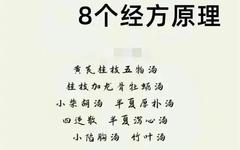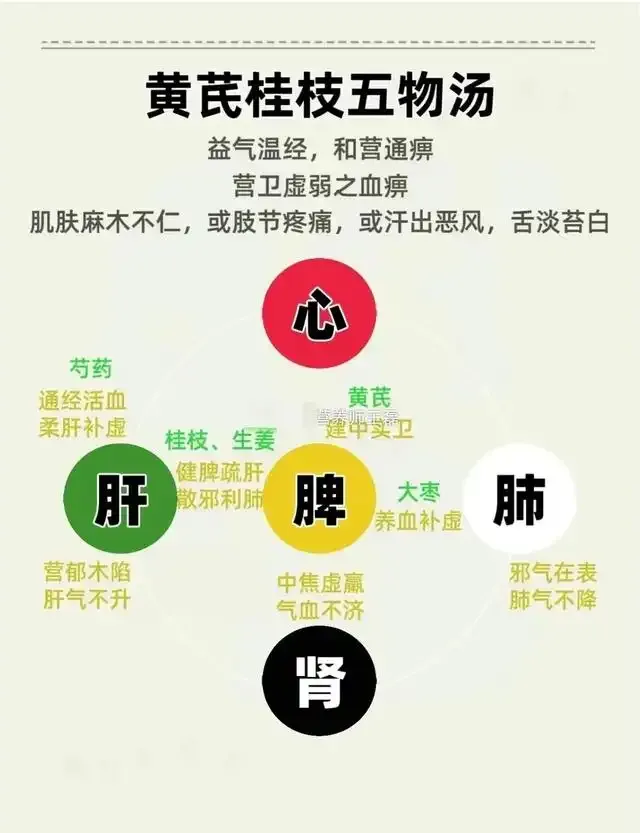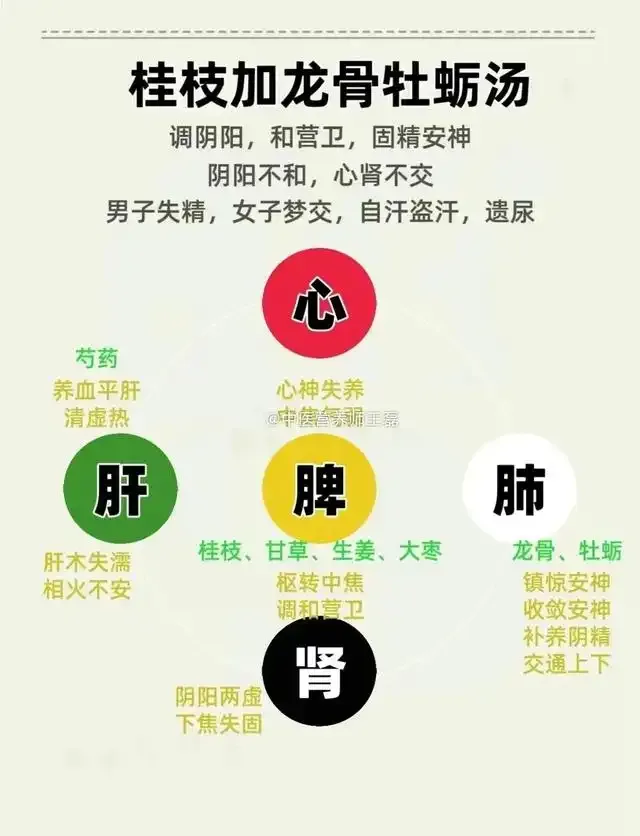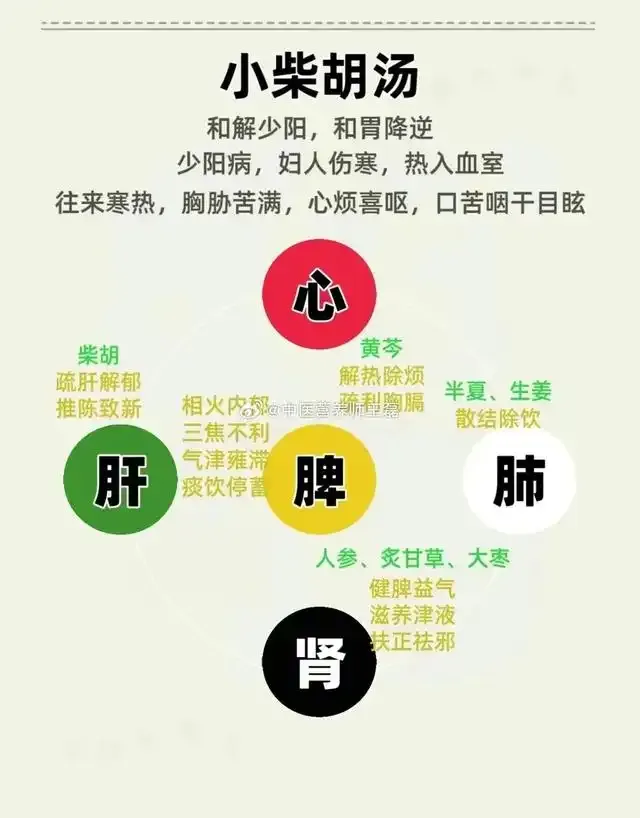Inheriting the legacy of Qi Huang, a public account with substance and warmth.
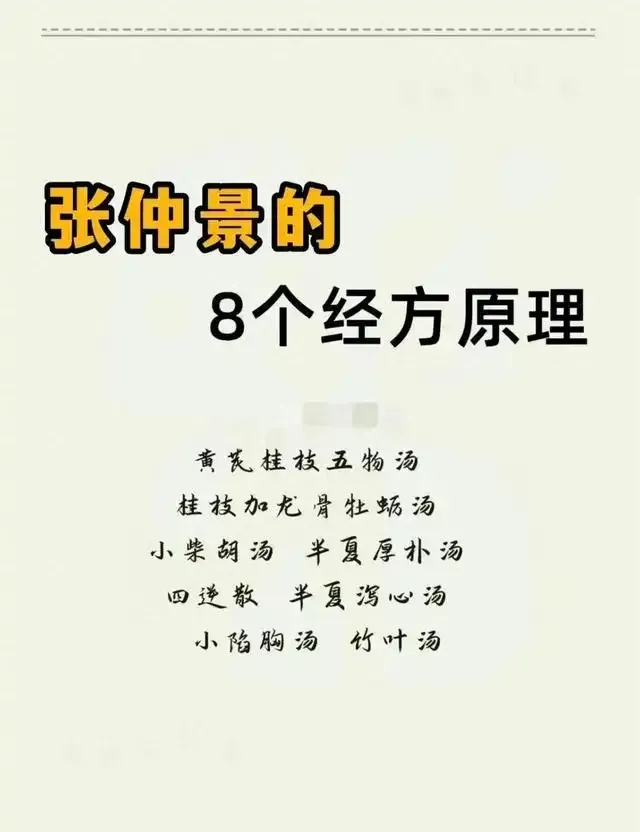
Verse: Huang Qi Gui Zhi Wu Wu Decoction, Shao Yao Da Zao and Sheng Jiang, benefits Qi, warms the meridians, harmonizes Ying and Wei, effective for blood bi and wind bi. Ingredients: Huang Qi 、Gui Zhi、Shao Yao、Sheng Jiang、Da Zao。
Dosage: Huang Qi 9g, Gui Zhi 9g, Shao Yao 9g, Sheng Jiang 18g, Da Zao 4 pieces.
Method: Combine the herbs, boil with six liters of water, reduce to two liters, and take seven portions warm, three times a day. Function: Benefits Qi, warms the meridians, harmonizes blood, and relieves bi.
Indications: Blood bi. Numbness and lack of sensation in the skin, pulse weak and tight. Formula meaning: In this formula, Huang Qi is the monarch, sweet and warm, benefiting Qi and supplementing the defensive Qi on the surface. Gui Zhi disperses wind and cold, warms the meridians, and relieves bi, working with Huang Qi to benefit Qi and warm Yang, harmonizing blood and opening the meridians. Gui Zhi, with the benefit of Huang Qi, invigorates the defensive Yang; Huang Qi, with Gui Zhi, secures the surface and prevents retention of pathogens. Shao Yao nourishes blood and harmonizes Ying, relieving blood bi, and works with Gui Zhi to harmonize Ying and Wei, balancing the exterior and interior, with both herbs as ministers. Sheng Jiang is acrid and warm, dispersing wind pathogens to assist Gui Zhi; Da Zao is sweet and warm, nourishing blood and benefiting Qi, supporting the functions of Huang Qi and Shao Yao; when combined with Sheng Jiang, it can also harmonize Ying and Wei, adjusting the other herbs as an assistant. Combination characteristics: Secures the surface without retaining pathogens, disperses pathogens without harming the upright Qi, balancing both pathogens and upright Qi. Application: This formula is commonly used to treat blood bi caused by insufficient Ying and Wei, with external wind pathogens. Clinically, key diagnostic points include numbness and lack of sensation in the skin, joint pain, or sweating with aversion to wind, with a weak pulse.
Verse: Men lose essence, women dream of intercourse, treatment lies in the middle hexagram, add Long Gu and Mu Li to Gui Zhi Decoction, three or two parts must be finely pounded.
Ingredients: Gui Zhi, Shao Yao, Sheng Jiang each 9g, Gan Cao 6g, Da Zao 12 pieces, Long Gu, Mu Li each 9g.
Method: Use 700ml of water, boil to obtain 300ml, divided into three warm doses.
Function: Harmonizes Yin and Yang, subdues and retains. Indications: Deficiency labor with tightness in the lower abdomen, cold in the genital area, dizziness, loss of essence in men, dream of intercourse in women, or palpitations, incontinence, weak and large pulse, or a weak and tight pulse.
Formula meaning: Deficiency labor caused by imbalance of Yin and Yang leads to tightness in the lower abdomen, cold in the genital area, loss of essence in men, dream of intercourse in women, or palpitations, etc., should be treated by harmonizing Yin and Yang, subduing and retaining. In this formula, Gui Zhi Decoction harmonizes Ying and Wei, adding Long Gu and Mu Li to subdue and retain, allowing Yang to secure and Yin to guard internally, achieving the function of balancing Yin and Yang, preventing essence leakage. After adding Long Gu and Mu Li to Gui Zhi Decoction, it still possesses the functions of warming Yang, dispersing cold, relieving muscle and promoting the surface, harmonizing Ying and Wei, and also has the functions of calming the spirit and securing and retaining.
Application: Use this formula for deficiency labor with tightness in the lower abdomen, cold in the genital area, dizziness, loss of essence in men, dream of intercourse in women, or palpitations, incontinence as key diagnostic points.
Modern application: Treating hysteria, insomnia, nocturnal emission or spermatorrhea, infertility, threatened miscarriage, chronic diarrhea, menopausal syndrome, night sweats, pediatric bronchitis, chronic urticaria, cervical spondylosis related to the above syndromes.
Verse: In Si Ni San use Chai Hu, Shao Yao, Zhi Shi, Gan Cao must be included, this is Yang depression causing counterflow, disperse and harmonize to eliminate counterflow.
Ingredients: Chai Hu, Shao Yao, Zhi Shi, Gan Cao.
Dosage: Gan Cao (roasted), Zhi Shi (broken, soaked in water, roasted dry), Chai Hu, Shao Yao each 6g.
Method: Combine the four ingredients, pound and sift, take with white drink (rice soup) in a spoonful, three times a day. Modern method: decoct in water.
Function: Disperse pathogens, relieve depression, soothe the liver and regulate the spleen.
Indications: 1. Yang depression counterflow syndrome. Cold hands and feet, abdominal pain, or diarrhea with heaviness, pulse wiry. 2. Liver and spleen Qi stagnation syndrome. Distension and fullness in the hypochondrium, abdominal pain, pulse wiry.
Formula meaning: This syndrome is often caused by external pathogens entering the interior, leading to Qi stagnation and Yang Qi depression. Treatment should focus on dispersing pathogens, relieving depression, soothing the liver, and regulating the spleen. Yang Qi depression cannot reach the extremities, resulting in cold hands and feet. This type of “Si Ni” is fundamentally different from the cold limbs caused by Yang deficiency and Yin excess. As Li Zhongzi said: “Although this syndrome is called Si Ni, it is not very cold, or the fingers are slightly warm, or the pulse is not deep but weak, which is a sign of Yin containing Yang, only Qi is not circulating, leading to counterflow cold.” In the formula, Chai Hu enters the liver and gallbladder meridians, raises Yang Qi, disperses liver Qi stagnation, and expels pathogens, serving as the monarch herb. Bai Shao nourishes Yin, tonifies blood, and softens the liver as the minister, working with Chai Hu to nourish liver blood and regulate liver Qi, allowing Chai Hu to disperse without damaging Yin blood. Assisted by Zhi Shi to regulate Qi and relieve depression, clear heat and break stagnation, and paired with Bai Shao, it can also regulate Qi and harmonize blood, ensuring the balance of Qi and blood. Sweetened with Gan Cao to harmonize the herbs and benefit the spleen.
Combination characteristics: Zhi Shi and Chai Hu work together, one ascending and one descending, enhancing the function of smoothing Qi, and achieving the effect of raising clear and lowering turbid. The original formula uses white drink (rice soup) to harmonize the central Qi, allowing Yin and Yang Qi to connect smoothly.
Application: This formula is used for Yang depression counterflow syndrome, with clinical application focusing on cold hands and feet, abdominal pain, or diarrhea with heaviness, and wiry pulse as key diagnostic points.
Verse: Ban Xia Hou Po Decoction with Zi Su, Fu Ling and Sheng Jiang together, phlegm congeals and Qi gathers to form a plum pit, descending counterflow opens depression and Qi flows freely.
Ingredients: Ban Xia 12g, Hou Po 9g, Fu Ling 12g, Sheng Jiang 15g, Zi Su Ye 6g.Method: Combine the five ingredients, boil with seven liters of water, reduce to four liters, divide into four warm doses, three times a day at night. Modern method: decoct in water.
Function: Move Qi, disperse stagnation, descend counterflow, transform phlegm.
Indications: Plum pit Qi. Sensation of obstruction in the throat, unable to cough out or swallow, may cough or vomit, tongue coating white and moist or white and slippery, pulse wiry.
Pathophysiology: Plum pit Qi is often caused by emotional stagnation and phlegm-qi obstruction. The liver likes smooth flow and dislikes depression, the spleen and stomach are responsible for the transformation and transportation of fluids, and the lungs regulate the water pathways. If emotions are not smooth, liver Qi stagnates, and the lung and stomach fail to descend, fluids become stagnant and form phlegm, which obstructs the throat, leading to the sensation of having something stuck; if the lung and stomach fail to descend, Qi flow is obstructed, resulting in fullness and discomfort in the chest, or cough or vomiting; white and moist or white and slippery tongue coating, wiry or slippery pulse are all signs of Qi stagnation and phlegm congealing. Treatment should focus on moving Qi, dispersing stagnation, descending counterflow, and transforming phlegm.
Formula explanation: In this formula, Ban Xia is acrid and warm, entering the lung and stomach, transforming phlegm, dispersing stagnation, and descending counterflow, serving as the monarch herb. Hou Po is bitter and acrid, warm in nature, descending Qi and relieving fullness, serving as the minister herb. The two herbs work together to transform phlegm and relieve stagnation, treating both phlegm and Qi. Fu Ling strengthens the spleen and drains dampness; when dampness is removed, phlegm cannot form; Sheng Jiang disperses stagnation, harmonizes the stomach, stops vomiting, and counteracts the toxicity of Ban Xia; Zi Su Ye is aromatic, moves Qi, regulates the lung, and assists Hou Po in moving Qi, opening the chest, and dispersing Qi stagnation, serving as the assistant herb. Together, the herbs achieve the function of moving Qi, dispersing stagnation, descending counterflow, and transforming phlegm.
Combination characteristics: Acrid and bitter work together to treat both phlegm and Qi, with movement and dispersal. Application: This formula is a representative formula for treating plum pit Qi caused by phlegm-qi obstruction, with key diagnostic points including sensation of obstruction in the throat, white greasy tongue coating, and wiry slippery pulse.
Verse: Xiao Chai Hu Decoction harmonizes, Ban Xia, Ren Shen, Gan Cao follow, add Huang Qin, Sheng Jiang, and dates, this formula is the essence of Shao Yang for all diseases.
Ingredients: Chai Hu 250g, Huang Qin 150g, Ren Shen 150g, Ban Xia 250g, Gan Cao 150g, Sheng Jiang 150g, Da Zao 12 pieces.
Method: Use 12 liters of water, boil to obtain 6 liters, strain, then decoct again to obtain 3 liters, take 1 liter warm, three times a day.
Function: Harmonizes and resolves Shao Yang.
Indications: 1. Shao Yang disease from cold damage. Pathogen is half in the exterior and half in the interior, symptoms include alternating chills and fever, fullness in the chest and hypochondrium, disinterest in food and drink, irritability, preference for vomiting, bitter mouth, dry throat, dizziness, thin white tongue coating, wiry pulse.
2. Women with cold damage. Heat enters the blood chamber. Menstrual flow is irregular, with intermittent chills and fever.
3. Malaria. Jaundice and other internal injuries presenting with the above Shao Yang disease symptoms.
Formula meaning: 1. This formula is a representative formula for harmonizing Shao Yang. The Shao Yang meridian runs through the chest and is located between the Tai Yang and Yang Ming. When the cold damage pathogen invades Shao Yang, the pathogen and upright Qi contend, with the upright Qi wanting to expel the pathogen from the exterior, while the pathogen wants to enter the interior and settle in the Yin, hence the alternating chills and fever; the foot Shao Yang pulse begins at the eye and descends through the chest, passing through the diaphragm, connecting to the liver, belonging to the gallbladder, and running through the hypochondrium; when the pathogen is in Shao Yang, the meridian Qi is obstructed, leading to heat transformation, causing fullness and discomfort in the chest and hypochondrium, irritability, bitter mouth, dry throat, and dizziness; when gallbladder heat invades the stomach, the stomach loses its harmony and descent, causing Qi to counterflow upwards, hence the disinterest in food and drink and preference for vomiting; if a woman during her menstrual period is affected by wind pathogens, the heat transmits internally, leading to blood heat stagnation, causing irregular menstrual flow. If the pathogen is in the exterior, it should be resolved by sweating; if it enters the interior, it should be expelled by vomiting or purging. Now that the pathogen is neither in the exterior nor in the interior, but between the two, it is not suitable for sweating, vomiting, or purging, hence the need for harmonizing methods.
In the formula, Chai Hu is bitter and neutral, entering the liver and gallbladder meridians, dispersing the Shao Yang pathogen, and can also smooth the Qi stagnation, serving as the monarch herb. Huang Qin is bitter and cold, clearing and draining the heat from the half interior of Shao Yang, serving as the minister herb. The ascending dispersing action of Chai Hu, combined with the descending draining action of Huang Qin, forms the basic structure for harmonizing Shao Yang. When gallbladder Qi invades the stomach, causing loss of harmony and descent, Ban Xia and Sheng Jiang are added to harmonize the stomach and descend counterflow to stop vomiting; the pathogen from Tai Yang transmits to Shao Yang, due to the deficiency of upright Qi, hence Ren Shen and Da Zao are added to benefit Qi and strengthen the spleen, one to support upright Qi to expel the pathogen, the other to benefit Qi to resist the internal transmission of the pathogen, ensuring the upright Qi is strong, thus the pathogen has no opportunity to enter. Roasted Gan Cao assists Ren Shen and Da Zao in supporting upright Qi, and can also harmonize the herbs, serving as the envoy herb. The combination of all herbs focuses on harmonizing Shao Yang while also supplementing stomach Qi, allowing the pathogen to be resolved, the pivot to be beneficial, and the stomach Qi to be harmonized, thus all symptoms will be eliminated.
2. Xiao Chai Hu Decoction is a harmonizing formula, generally after taking the medicine, the disease resolves without sweating, but there are also cases where sweating occurs after taking the medicine, which is due to the upright Qi overcoming the pathogen, and the stomach Qi being harmonized. As stated in the Treatise on Cold Damage: “When the upper burner is open, the fluids descend, and the stomach Qi is harmonized, the body sweats and resolves.” If the Shao Yang disease is mismanaged and the upright Qi is damaged, or if the patient has a deficiency of upright Qi, taking this formula may also lead to the phenomenon of “battle sweat” where there is first a chill followed by fever and sweating, which is a sign of the upright Qi overcoming the pathogen.
Combination characteristics: 1. Chai Hu is bitter and neutral, ascending and dispersing, Huang Qin is descending and draining, and the combination of the two forms the basic structure for harmonizing Shao Yang. 2. The combination of all herbs focuses on harmonizing Shao Yang while also supplementing stomach Qi, allowing the pathogen to be resolved, the pivot to be beneficial, and the stomach Qi to be harmonized, thus all symptoms will be eliminated.
Application: 1. This formula is a foundational formula for treating Shao Yang disease from cold damage, and is also a representative formula for harmonizing Shao Yang. Clinical application focuses on alternating chills and fever, fullness in the chest and hypochondrium, disinterest in food and drink, irritability, preference for vomiting, bitter mouth, dry throat, thin white tongue coating, and wiry pulse as key diagnostic points. Clinically, as long as one or two of the main symptoms from the first four are captured, this formula can be used for treatment without waiting for all symptoms to be present. As stated in the Treatise on Cold Damage: “In cases of cold damage with wind, if there is a Chai Hu symptom, just seeing one symptom is sufficient, there is no need to see all symptoms.” 2. This formula is often used for colds, influenza, malaria, chronic hepatitis, liver cirrhosis, acute and chronic cholecystitis, gallstones, acute pancreatitis, pleuritis, otitis media, puerperal fever, acute mastitis, orchitis, and reflux gastritis, as well as gastric ulcers, all of which belong to conditions where the pathogen resides in Shao Yang, and the gallbladder and stomach are not in harmony.
Verse: Xiao Xian Xiong Decoction with Ban Xia, clear heat and transform phlegm, widen the chest, disperse stagnation, relieve fullness and pain, yellow tongue coating and slippery pulse, this formula is sought. Ingredients: Huang Lian, Ban Xia, Gua Lou.
Dosage: Huang Lian 6g, Ban Xia (washed) 12g, Gua Lou 20g.
Method: Combine the three ingredients, boil with six liters of water, first boil Gua Lou, obtain three liters, strain, add the other herbs, boil to obtain two liters, strain, divide into three warm doses. Modern method: first boil Gua Lou, then add the other herbs, decoct in water and take warm.Function: Clear heat, transform phlegm, widen the chest, disperse stagnation.
Indications: Chest obstruction due to phlegm heat. Fullness and discomfort in the chest, pain upon pressure, or chest pain, or cough with yellow thick phlegm, red tongue with yellow greasy coating, slippery and rapid pulse.
Formula meaning: This formula originally treats cold damage exterior syndrome mismanaged with purging, leading to heat and phlegm congealing in the heart area. Phlegm heat obstructs the heart or chest, causing Qi stagnation and discomfort in the stomach or heart, leading to pain upon pressure. Treatment should focus on clearing heat, transforming phlegm, widening the chest, and dispersing stagnation. In the formula, Gua Lou is sweet and cold, clearing heat and transforming phlegm, widening the chest and dispersing stagnation, used first to “treat the upper gently”; while also unblocking the obstruction in the chest. The minister herbs Huang Lian is bitter and cold, draining heat and relieving fullness, and Ban Xia is acrid and warm, transforming phlegm and dispersing stagnation.
Combination characteristics: The two herbs work together, one bitter and one acrid, representing the method of opening with acrid and descending with bitter; when combined with Gua Lou, they complement each other to clear heat, transform phlegm, and disperse stagnation, making it a commonly used combination. Application: This formula is commonly used for treating chest obstruction due to phlegm heat. Clinical application focuses on fullness and discomfort in the chest, pain upon pressure, red tongue with yellow greasy coating, and slippery rapid pulse as key diagnostic points.
Verse: Ban Xia, Xie Xin, Huang Lian, Qin, Gan Jiang, Cao, Da Zao, Ren Shen act together, acrid opens and bitter descends to relieve fullness, treating the balance of Yang and harmonizing Yin.
Ingredients: Ban Xia, Huang Lian, Huang Qin, Gan Jiang, Gan Cao, Da Zao, Ren Shen.
Dosage: Ban Xia 15g, Huang Qin, Gan Jiang, Ren Shen, and roasted Gan Cao each 9g, Huang Lian 3g, Da Zao 4 pieces.
Method: Combine the seven ingredients, use 10 liters of water, boil to obtain 6 liters, strain, then decoct again to obtain 3 liters, take 1 liter warm, three times a day. Modern method: decoct in water.
Function: Balance cold and heat, relieve fullness and disperse stagnation.
Indications: Mixed cold and heat fullness syndrome. Fullness in the heart area, but not painful, or vomiting, rumbling in the intestines, tongue coating greasy and slightly yellow.
Formula meaning: The fullness treated by this formula is caused by mismanagement of Xiao Chai Hu Decoction, damaging the middle Yang, with Shao Yang heat invading the interior. Treatment should focus on balancing cold and heat, relieving fullness and dispersing stagnation. The heart area refers to the stomach, which is a change in the spleen and stomach. The spleen and stomach are located in the middle burner, serving as the pivot for the rise and fall of Yin and Yang. When the central Qi is weak, cold and heat mix, leading to fullness. The spleen Qi governs the rise, and the stomach Qi governs the descent; when the rise and fall are abnormal, vomiting and rumbling occur. In the formula, Ban Xia disperses fullness and relieves stagnation, serving as the monarch herb; Gan Jiang warms the middle and disperses pathogens, Huang Qin and Huang Lian are bitter and cold, draining heat and relieving fullness, serving as the minister herbs; Ren Shen and Da Zao are sweet and warm, benefiting Qi and tonifying the spleen, serving as the assistant herbs; Gan Cao harmonizes the herbs, serving as the envoy herb.
Combination characteristics: Cold and heat are used together to harmonize Yin and Yang, acrid and bitter work together to regulate the rise and fall, and tonifying and draining are applied to consider the deficiency and excess.
Application: This formula is used for mixed cold and heat fullness syndrome. Clinical application focuses on fullness in the heart area, but not painful, or vomiting, rumbling in the intestines, greasy and slightly yellow tongue coating as key diagnostic points.
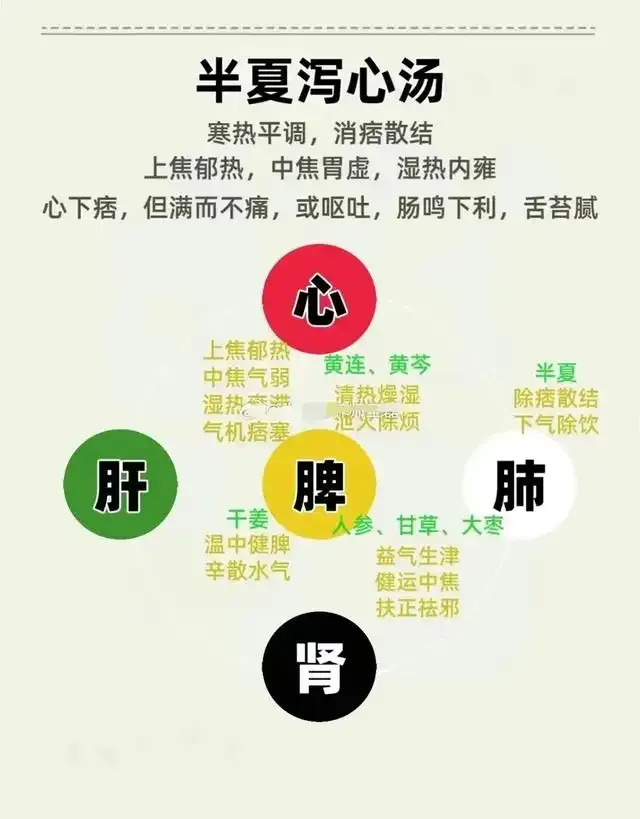
The content of this article is for reference only, non-professional doctors should not attempt acupuncture or medication.

